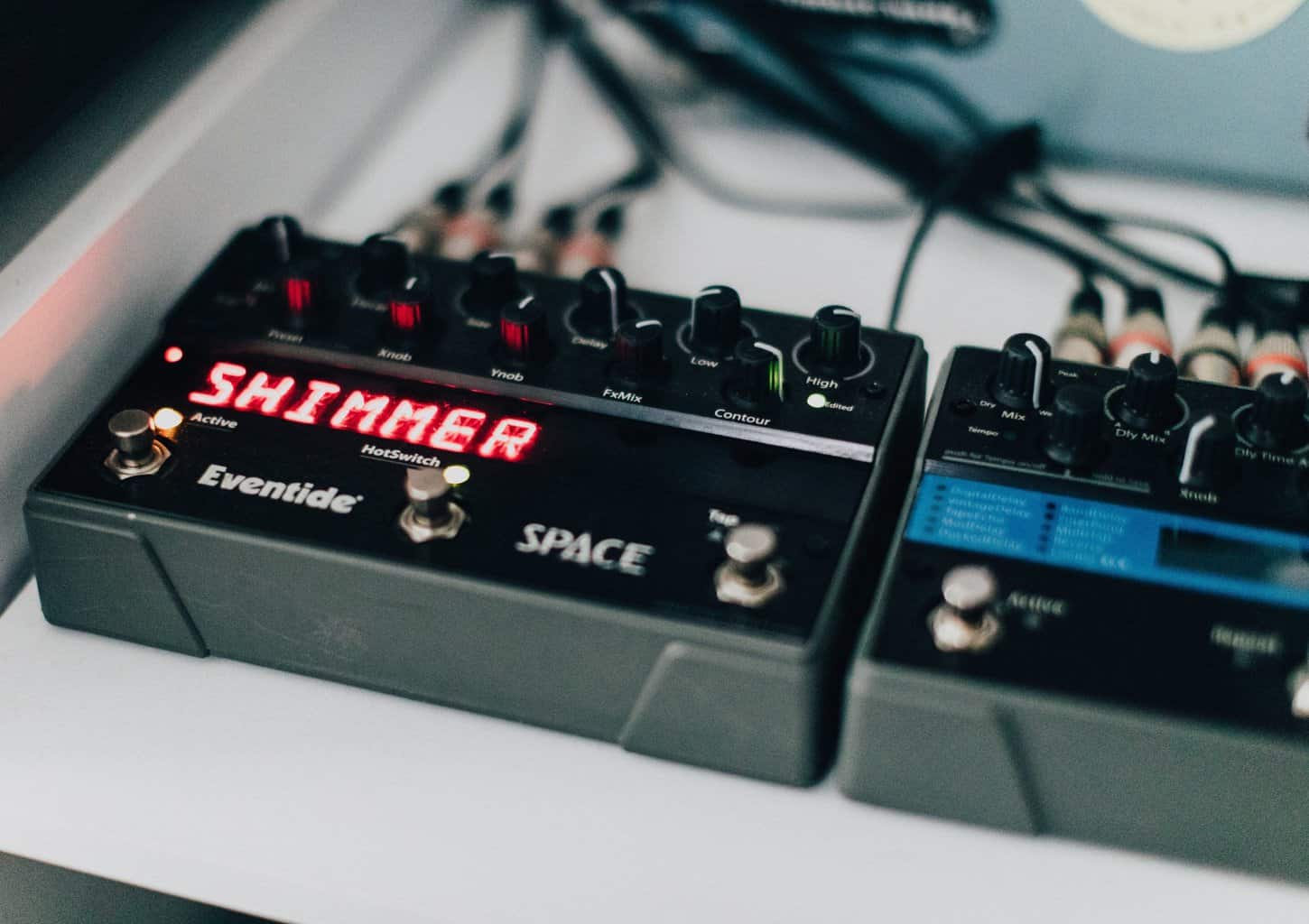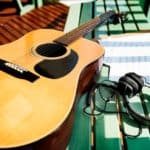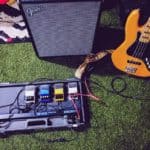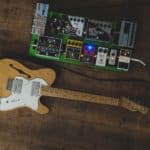Pedal effects make a significant difference.
Sometimes, it is thanks to them that memorable riffs exist.
Otherwise, a flat tone could not fit the style of a certain genre.
If this happens, then all you need to do is get the right pedal effect and you are all set!
Now, what happens when you are playing with acoustic guitars?
Obviously, an effect pedal will work on electric guitars. But will they do the same to electro-acoustics?
Every guitar pedal can work on electro-acoustic guitars. Some of them are more suitable than others. However, with the proper settings, any effect pedal can create wonderful results.
Let’s dig deeper into this topic.
You’ll find out which pedals are the best option for your acoustics, and more!
Remember you can only use pedals with electro-acoustic guitars
Electro-acoustics and regular acoustics are similar.
However, they differ because of certain reasons.
The main differentiation relies on the capacity of electro-acoustics to be plugged in an amp.
That is to say, electro-acoustics have built-in pickups. This allows controlling EQ and volume, which can be useful for live performances.
Other than that, their structure is pretty alike.
Want to learn more about them? Not sure which one you want to buy? Then read this article where we compare one with the other.
Are electric and acoustic guitar effect pedals the same?
Both electric and electro-acoustic guitars can work with the same pedals.
The real difference relies on the final results. After all, even if you use the same effect pedal, you’ll find contrasting outcomes.
This is because of the nature of the instrument. Needless to say, an electro-acoustic has a certain sound that an electric guitar has not.
So, for example, playing with a fuzz pedal will create two contrasting tones, depending on the instrument you are playing with. Apart from that, the pedal is no different.
Why then, a guitar pedal can work for both instruments?
The reason is simple. The effect pedal cannot know the difference between one and the other.
Whether it is electric or acoustic, it won’t change a thing.
The signal received is of the same kind.
Are there effect pedals exclusive for acoustic guitars?
The keyword here should not be “exclusive”. Instead, let’s point out how these pedals are “designed” for acoustics.
What’s the difference? Well, there are no pedals that solely work on electro-acoustics.
As I already mentioned, pedals don’t notice a differentiation between one and the other.
They work for both, so there is no exclusivity.
However, it is safe to mention that certain effect pedals do work better on acoustics than others.
For example, reverb or a chorus will suit more appropriately than a fuzz. But we’ll focus on that later on.
Lastly, consider that there are determined marks that the main design is made for acoustics (but once again, they work on regular electrics as well).
Just to mention a few, check the Transit A Acoustic preamp pedal, the Tech 21 Acoustic Fly Rig, or the Zoom AC-3 Acoustic Creator.
Can you use any electric guitar pedal with an acoustic?
Indeed, every electric guitar pedal works on acoustics.
The signal that both guitar types produce is of the same kind.
As long as the acoustic has an output jack to plug in the cable, there won’t be a problem.
Sure enough, some pedals will need a proper setting to sound appropriate.
Would electric guitar effects sound good on an acoustic?
No unique answer has this question.
Lots of effects are designed exclusively for electric guitars, while others may have been made with acoustics in mind.
Now, plenty of electric guitar effects work marvelously on electro-acoustics.
We’ll talk about them below.
Meanwhile, consider the following.
The best approach to discovering whether a pedal will suit well or not is to experiment with them.
Find out the ones that fit your style and expectations.
Toy with them as if you were a child. Test them all, like a scientist getting rid of hypotheses to leave room for newer ones.
Maybe some pedals work well with specific configurations. Maybe some others work well with any configurations.
Who knows? Take this task from a funny perspective.
Possibilities are endless.
What are the most common pedal effects used on acoustic guitar?
Time to analyze the most suitable choices for electro-acoustic guitars.
You’ll also find one or two that are not exactly “common”.
Despite that, they are worth trying.
Here’s the list:
- Chorus: modulation effects suit perfectly in acoustic guitars. Since chorus is a modulation effect, it will work fantastic. It will add an 80’s kind of feeling to the sound of the guitar.
- Phaser: another modulation pedal. Its smooth billow effect creates a beautiful atmosphere.
- Flanger: with the proper settings, a flanger pedal provides a glittering tone.
- Delay: a very popular effect for electric guitarists. It warms up the tone, and mixing it up to high levels creates a muffled atmosphere that doesn’t sound invasive.
- Reverb: reverbs intensify the acoustic sound the guitar provides.
- Octaver: pitch-shifting pedal to play either an octave above or below. Some people could use this to make the acoustic sound like a bass guitar.
- Compressors: these pedals level the dynamics and stabilize the volume level.
- EQ pedals: very useful for shaping the amp’s tone and boosting the sound.
What effects will not sound good on an acoustic guitar?
With the proper settings, every pedal can find its use.
However, it is also true that they may need lots of changes before creating something bearable to our ears.
For example, overdrives, distortions, or fuzz effects cannot be a top-notch selection.
They are bound to result in a cluttery wave of distorted noise, which is far from what acoustics are made for.
Now, if you are planning to give them a try despite all odds, I recommend you play at low volumes.
Higher volumes will create intolerable feedback loops.
Can you use an electric guitar amplifier for an acoustic guitar?
Acoustic guitars can be plugged in electric guitar amps.
While there might be minor changes regarding tone, real issues won’t emerge.
Whether you should use one or the other, that depends on lots of reasons.
To find them out, read this article. You’ll dissipate any doubt!
Can you use multi-effect pedalboards with acoustic guitars?
It is possible to use multi-effect pedalboards on acoustics.
Multi-effect pedals tend to be placed after the tuner, compressor, and distortion of a pedal signal chain.
They emulate the chains of individual pedals. Also, they can emulate guitar amps and cabinets, which, of course, work well on electro-acoustic guitars.
Is it common to use effect pedals with an acoustic guitar?
The word “common” doesn’t make justice to the question.
It might be a fact that the majority of guitarists play without pedals when using acoustics.
Nonetheless, playing with pedals is neither a rarity. A wide number of musicians love experimenting with them.
Some even add a chain of pedals to create unique, memorable tones.
Again, trying them out is a healthy hobby that could lead to unimaginable results.
Plus, it also helps to acquire a deeper understanding of the world of music.
If you are still not convinced about the quality of effect pedals for acoustic, just take a listen to the biggest musicians.
The guitar riff of Nirvana’s Come As You Are is so memorable thanks to its chorus effect.
They even played with it in their acoustic version for the MTV Unplugged.
Also, listen to The Man Who Sold The World intro from the same session. Another vivid example of how relevant acoustic pedals can be.
Maybe you are more of a classic guitarist and prefer sticking simply to the guitar and an amp.
That’s fine. You should always find your style and stick to it.
However, experimenting a bit now and then is also beneficial.
You may end up changing your style forever.

Hello there, my name is Ramiro and I’ve been playing guitar for almost 20 years. I’m obsessed with everything gear-related and I thought it might be worth sharing it. From guitars, pedals, amps, and synths to studio gear and production tips, I hope you find what I post here useful, and I’ll try my best to keep it entertaining also.





